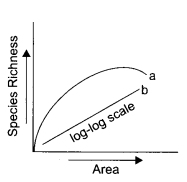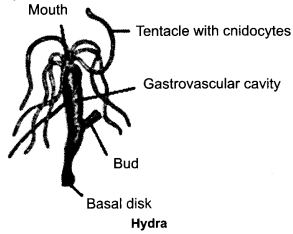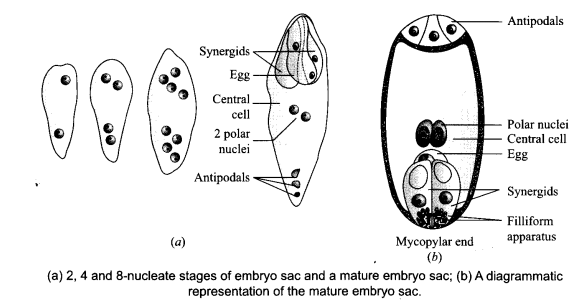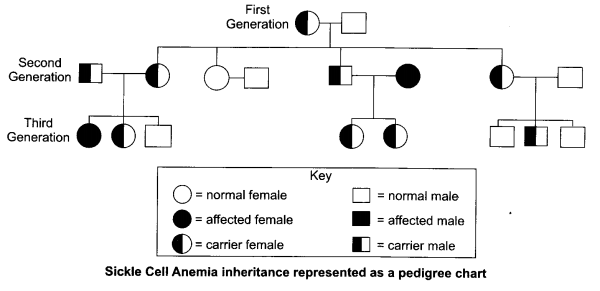These Sample papers are part of CBSE Sample Papers for Class 12 Biology. Here we have given CBSE Sample Papers for Class 12 Biology Paper 7.
CBSE Sample Papers for Class 12 Biology Paper 7
| Board | CBSE |
| Class | XII |
| Subject | Biology |
| Sample Paper Set | Paper 7 |
| Category | CBSE Sample Papers |
Students who are going to appear for CBSE Class 12 Examinations are advised to practice the CBSE sample papers given here which is designed as per the latest Syllabus and marking scheme as prescribed by the CBSE is given here. Paper 7 of Solved CBSE Sample Paper for Class 12 Biology is given below with free PDF download solutions.
Time Allowed: 3 hours
Maximum Marks: 80
General Instructions:
- There are total 26 questions and five sections in the question paper. All questions are compulsory.
- Section A contains question number 1 to 5, Very Short Answer Type Questions of one mark each.
- Section B contains question number 6 to 10, Short Answer Type Questions of two marks each.
- Section C contains question number 11 to 22, Short Answer Type Questions of three marks each.
- Section D contains question number 23, Value Based Question of four mark.
- Section E contains question number 24 to 26, Long Answer Type Questions of five marks each.
- There is no overall choice in the question paper, however, an internal choice is provided in one question of two marks, one question of three marks and all three questions of five marks. An examiner is to attempt any one of the question out of the two given in the question paper with the same question number.
- No. of printed pages are three.
SECTION-A
Question 1.
A human zygote has XXY sex chromosomes along with 22 pairs of autosomes. What sex will the individual be?
Question 2.
Define linkage.
Question 3.
What is Brood Parasitism?
Question 4.
Which enzyme is known as ‘molecular scissors’?
Question 5.
Expand ELISA.
SECTION-B
Question 6.
Give an account of surgical sterilization methods in males and females.
Question 7.
What are biological response modifiers?
Question 8.
What are histones?
Question 9.
What is soluble RNA? Illustrate.
Question 10.
What are the pre-fertilisation events in plants?
SECTION-C
Question 11.
Write the importance of bagging of unisexual flowers in crop improvement programme.
Question 12.
Elaborate the asexual mode of reproduction in the following:
(a) Chalmydomonas
(b) Hydra
(c) Yeast
Question 13.
What are the symptoms of the disease which are confirmed by a Widal test?
OR
What are the complexities involved in transcription of eukaryotic DNA?
Question 14.
Describe the responsibility of GEAC, set up by the Indian Government.
Question 15.
Explain the hormonal control of spermatogenesis in humans.
Question 16.
During his studies on genes in Drosophila that were sex-linked, T.H. Morgan found population
phenotypic ratios deviated from expected 9 : 3 : 3 : 1. Explain the conclusion he arrived at. 3
Question 17.
A person claimed that he has seen sounds, heard colours and smelt light.
(1) What could be the possible reasons?
(2) Name two chemicals responsible for this condition.
(3) Mention any one source of these chemicals.
Question 18.
What are the requisites of a cloning vector?
Question 19.
Explain gene therapy with an example.
Question 20.
What are the factors that contribute to Population density?
Question 21.
(a) Name the technology that has helped the scientists to propagate on large scale the desired crops in short duration. List the steps carried out to propagate the crops by the said technique.
(b) How are the somatic hybrid obtained?
Question 22.
What is “The Evil Quartet?
SECTION-D
Question 23.
Hanshal purchased one high milk yielding exotic breed of cow. Within a few years he earned lot of money by selling calves by using MOET. The mother cow met with a premature death. Raman objected to Hansal earning money by this way.
(a) What values in life did Raman possess?
(b) Expand MOET.
(c) Briefly describe the process.
SECTION-E
Question 24.

The following graph shows the species-area relationship. Answer the following questions as directed: 5
(a) Name the naturalist who studied the kind of relationship shown in the graph. Write observations made by him.
(b) Write the situations as discovered by the ecologists when the value of ‘Z’ (slope of the line) lies between
1. 0.1 and 0.2
2. 0.6 and 1.2
What does ‘Z’ stand for?
(c) When would the slope of the line ‘ff become steeper?
OR
List the observations of Human Genome Project
Question 25.
Explain and illustrate the development of the embryo sac.
OR
How are infertility problems overcome?
Question 26.
Elaborate on the key abiotic elements that contribute to the variation in habitats.
OR
Explain sickle cell anemia and its inheritance as a pedigree chart.
Answers
SECTION-A
Answer 1.
The individual will be a male.
Answer 2.
When two genes in a dihybrid cross are situated on the same chromosome, the proportion of
parental gene combinations is much higher than the non-parental type. This physical association of genes on a chromosome is termed as linkage.
Answer 3.
The parasitic bird lays it eggs in the nest of its host and lets the host bird incubate its eggs.
This is called Brood parasitism. The eggs of the parasitic bird have evolved to resemble the host’s egg in size and colour to reduce the chances of the host bird detecting the foreign eggs and ejecting them from the nest.
Answer 4.
Restriction enzymes.
Answer 5.
Enzyme Linked Immuno Sorbent Assay.
SECTION-B
Answer 6.
Surgical Sterilization method in male is called ‘vasectomy’ where a small part of the vas deferens is removed or tied up through a small incision on the scrotum.
The surgical method followed in female is called tubectomy where a small part of the fallopian tube is removed or tied up through a small incision in the abdomen or through vagina.
Answer 7.
Biological Response Modifiers (BRM) are the substances given to the cancer patients which activates the immune system for detection and destroying of tumor cell. For example, interferon. List the specific symptoms of typhoid. Name its causative agent.
Answer 8.
Specific symptoms of typhoid are:
- Constant high fever (39° to 40° C).
- Weakness
- Stomach pain
- Loss of appetite.
Its causative agent is Salmonella typhi.
OR
Histones are positively charged, basic proteins that are organised to form a unit of eight molecules called as histones octamer. The negatively charged DNA is wrapped around the positively charged histone octamer to form a structure called nucleosome.
Answer 9.
Soluble RNA or tRNA is an adapter molecule that would on one hand read the code and on other hand bind to the specific amino acids thereby facilitating protein synthesis. The term was coined by Francis Crick.
Answer 10.
The two main pre-fertilisation events in plants are:
(1) Gametogenesis: Refers to the process of formation of two gametes — male and female.
These gametes can be homogametes (haloid) or heterogametes (diploid), sperm and ovum.
(2) Gamete Transfer: Male and female gametes are physically brought together to facilitate fusion.
SECTION-C
Answer 11.
Bagging is a process where the emasculated flowers are covered with a bag of butter paper to prevent contamination of stigma with unwanted pollen. When this stigma attains receptivity, mature pollen grains of the desired plants with required traits are dusted on the stigma and the flowers are rebagged to allow the fruits to develop. This ensures the pollen grains of only desired plants are used for fertilisation of the stigma to develop the desired plant variety.
Answer 12.
Chlamydomonas is an alga which reproduces by formation of zoospores which are
(a) micropscopic motile structures.

(b) Hydra reproduces by the formation of buds which bud from the parent body.

(c) In Yeast, the division is unequal and small buds are produced that remain attached initially to the parent cell which, eventually gets separated and mature into new yeast organisms.

Answer 13.
Typhoid fever is confirmed by Widal test.
Substained high fever (39° to 40°C), weakness, stomach pain, constipation, headache and loss of appetite are some of the common symptoms of this disease. Intestinal perforation and death may occur in severe cases.
OR
There are two complexities involved in transcription of eukaryotic DNA:
(a) There are at least three RNA polymerases in the nucleus (in addition to the RNA polymerase found in the organelles)
- The RNA polymerase I transcribes rRNAs (28S, 18S, and 5.85), whereas the
- The RNA polymerase II transcribes precursor of mRNA, the heterogeneous nuclear RNA (hnRNA).
- RNA polymerase III is responsible for transcription of tRNA, and 5snRNA, and snRNAs
(small nuclear RNAs)
(b) Secondly, the primary transcripts contain both the exons and the introns which are non-functional. Hence, it is subjected to a process called splicing where the introns are removed | and exons are joined in a defined order.
Answer 14.
GEAC (Genetic Engineering Approval Committee) is an Indian Government organisation. Its responsibilities are:
(1) To examine the validity of GM (Genetic Modification of Organism) research.
(2) To inspect the safety of introducing GM for public services and for their large scale use.
Answer 15.
Spermatogenesis starts at the age of puberty due to significant increase in the secretion of
Gonadotropin Releasing Hormone (GnRH). The increased levels of GnRH then acts at
the anterior pituitary gland and stimulates secretion of two gonadotropins – Luteinising
[ Hormone (LH) and Follicle Stimulating Hormone (FSH). LH acts at the Leydig cells and
stimulates synthesis and secretion of androgens. Androgens, in turn, stimulate the process of spermatogenesis. FSH acts on the sertolli cells and stimulates secretion of some factors which
f help in the process of spermiogenesis.
Answer 16.
He observed that when the two genes in a dihybrid cross are located on the same chromosome the proportion of parental gene combinations in the progency was much higher than the non-parental or recombination of genes:
(1) Morgan and his group found that when genes are grouped on the same chromosome, some genes are tightly linked and show less recombination.
(2) When the genes are loosely linked, they show higher combination.
Answer 17.
(1) Hallucination.
(2) LSD, Cocaine.
(3) Erythroxylum cocal/Athropa belladona/Datura sps.
Answer 18.
Requisites of a cloning vector are:
(a) Origin of replication (ori): This is a sequence where replication of DNA starts within the host cells.
(b) Selectable Marker: These help in identifying and eliminating non-transformants and selectively permits the growth of the transformants.
(c) Cloning sites: This involves linkage of the alien DNA of the vector to a recognition sites
for the commonly used restriction enzymes.
Answer 19.
Gene therapy is a technique of genetic engineering with a collection of methods that allows correction of a gene defect that has been diagnosed in child/embryo by the insertion of a normal functional gene into the individual or embryo to take over the function of and compensate for the non-functional gene.
For example, the first clinical gene therapy was given for adenosine deaminase (ADA) deficiency which was caused due to the deletion of the gene for adenosine deaminase. It can be cured by bone marrow transplantation or enzyme replacement therapy, in which functional ADA is given to the patient by injection.
Steps included in Gene therapy are:
- Lymphocytes from the blood of the patient are grown in a culture outside the body.
- A functional ADA cDNA (using a retroviral vector) is then introduced into these lymphocytes, which are subsequently returned to the patient.
- Periodic infusion of such genetically engineered lymphocytes into the patient.
- The gene isolated from marrow cells producing ADA introduced into cells at early embryonic stages could be a permanent cure.
Answer 20.
The density of a population in a given habitat during a given period, fluctuates due to changes in four basic processes.
(a) Natality refers to the number of births during a given period in the population that are added to the initial density.
(b) Immigration is the number of individuals of the same species that have come into the habitat from elsewhere during the time period under consideration.
(c) Mortality is the number of deaths in the population during a given period.
(d) Emigration is the number of individuals of the population who left the habitat and gone elsewhere during the time period under consideration.
Hence, Natality and Immigration contribute to an increase in population density whereas Mortality and Emigration decrease it.
Answer 21.
(a) The technology that has helped the scientists to propagate the desired crops on large scale is tissue culture or micropropagation.
The steps to propagate crops are:
- Obtaining an explant from a plant.
- Growing the explant in a test tube under sterile conditions.
- A special nutrient or culture medium is provided for growth.
(b) Isolated single cells are separated from the plants. Their cell walls are digested to obtain protoplasts. Isolated protoplasts from two different plant varieties are fused to get hybrid protoplasts.
Answer 22.
Accelerated rates of species extinction are due to four main causes which is called the Evil Quartet. These are:
(a) Habitat loss and fragmentation
(b) Over-exploitation
(c) Alien species invasions
(d) Co-extinctions.
SECTION-D
Answer 23.
(a) Raman was bold, having love for animals. He had ethics and prudence.
(b) Multiple Ovulation Embryo Transfer Technology.
(c) A cow is administered with FSH-like activity, to induce follicular maturation and super ovulation to produce 6-8 eggs in a single cycle.
- The superovulated cow is either mated with an elite bull or artificially inseminated,
- The fertilised eggs at 8-32 cells stages, are recovered non-surgically and transferred to surrogate mothers.
- The genetic mother is available for another round of super ovulation.
SECTION-E
Answer 24.
(a) Alexander Von Humboldt
He observed that within a region, species richness increased in explored area but only up to a limit.
(b)
- The slopes regression lines are similar when unaffected distribution in an area is analysed.
- The slope of regression is steeper when we analyse the species area relationship among very large areas like entire continent. Z (slope of line) is the regression co-efficient.
(c) If species richness is more, i.e., in the range 0.62-1.2.
OR
The salient observations drawn from Human Genome Project are:
- The human genome contains 3164.7 million nucleotide bases.
- The average gene consists of 3000 bases, but sizes very greatly, with the largest known human gene being dystrophin at 2.4 million bases.
- The total number of genes is estimated at 30,000-much lower than previous estimates of 80,000 to 1,40,000 genes. Almost all (99.9 per cent) nucleotide bases are exactly the same in all people.
- The functions are unknown for over 50 per cent of the discovered genes.
- Less than 2 per cent of the genome codes for proteins.
- Repeated sequences make up very large portion of the human genome.
- Repetitive sequences are stretches of DNA sequences that are repeated many times, sometimes hundred to thousand times. They are thought to have no direct coding functions, but they shed light on chromosome structure, dynamics and evolution.
- Chromosome 1 has most genes (2968), and the Y has the fewest (231).
- Scientists have identified about 1.4 million locations where singlebase DNA differences (SNPs-single nucleotide polymorphism, pronounced as ‘snips’) occur in humans. This information/promises to revolutionise the processes of finding chromosomal locations for disease-associated sequences and tracing human history.
Answer 25.
The nucleus of the functional megaspore divides mitotically to form two nuclei which move to the opposite poles, forming the 2-nucleate embryo sac. Two more sequential mitotic nuclear divisions result in the formation of the 4-nucleate and later the 8-nucleate stages of the embryo sac. Nuclear divison are not followed immediately by cell wall formation. After the 8-nucleate stage, cell walls are laid down leading to the organisation of the typical female gametophyte or embryo sac. Six of the eight nuclei are surrounded by cell walls and organised into cells; the remaining two nuclei, called polar nuclei are situated below the egg apparatus in the large central cell. There is a characteristic distribution of the cells within the embryo sac. Three

cells are grouped together at the micropylar end and constitute the egg apparatus. The egg apparatus, in turn, consists of two synergids and one egg cell. The synergids have special celluclar thickenings at the micropylar tip called filiform apparatus, which play an important role in guiding the pollen tubes into the synergid. Three cells are at the chalazal end and are called the antipodals. The large central cell has two polar nuclei. Thus, a typical angiosperm embryo sac, at maturity is 8-nucleate and 7-celled.
OR
Infertility problems are overcome by Assisted Reproductive Technologies (ART). Some ART techniques are depicted below:
(a) In vitro fertilisation (IVF): This method is popularly known as test tube baby programme, where ova from the wife/donor (female) and sperms from the husband/donor (male) are collected and are induced to form zygote under simulated conditions as that in the body followed by embryo transfer (ET) in the laboratory.
The zygote or early embryo with upto 8 blastomeres is then transferred into the fallopian tube (ZIFT-zygote infra fallopian transfer). If the embryo is with more than 8 blastomeres, it is transferred into the uterus (IUT-intra uterine transfer) to complete its further development. This technique can also be used to assist females who cannot conceive.
(b) GIFT-Gamete Intro Fallopian Transfer: Here, ovum collected from a donor is transferred into the fallopian tube of another female who cannot produce one but can provide suitable environment for fertilisation.
(c) Intra Cytoplasmic Sperm Injection (ICSI): An embryo in the laboratory is formed by injecting sperm directly into the ovum. The embryo so formed is later transferred by IUT. (e) Artificial Insemination (AI) Technique: In this technique, the semen collected either from the husband or a healthy donor is artificially introduced either into the vagina or into the uterus (IUI-intra-uterine insemination) of the female.
Answer 26.
The important abiotic components that contribute to the variation in habitats are:
(1) Temperature: It affects the kinetics of enzymes activity and other physiological functions of the organism. The levels of thermal tolerance of different species also determine their geographical distribution to a larger extent.
(2) Water: The productivity and distribution of plants is heavily dependent on water. For aquatic organisms the quality (chemical composition, pH and salinity) of water becomes important. Some organisms are tolerant of a wide range of salinities while others are restricted to a narrow range (stenohaline). Many freshwater animals cannot live for long in sea water and vice versa because of the osmotic problems, they would face.
(3) Light: It is required for
(a) photosynthesis,
(b) flowering, and
(c) diurnal and seasonal migrations of organisms, for e.g., photopheriodism and hibernation.
(4) Soil: It is a very important ecological factor as it provides water, minerals and nutrients and support to the producers.
OR
Sickle cell anemia is an autosome linked recessive trait that can be transmitted from parents to the offspring when both the partners are carrier for the gene (or heterozygous).
The disease is controlled by a single pair of allele, HbA and HbS. Out of the three possible genotypes only homozygous individuals for HbS (HbSHbS) show the diseased phenotype. Heterozygous (HbAHbS) individuals appear apparently unaffected but they are carrier of the diseases as there is 50 per cent probability of transmission of the mutant gene to the progeny, thus exhibiting sickle-cell trait. The defect is caused by the substitution of Glutamic acid (Glu) by Valine (Val) at the sixth position of the beta globin chain of the haemoglobin molecule. The substitution of amino acid in the globin protein results due to the single base substitution at the sixth codon of the beta globin gene from CAG to GUG. The mutant haemoglobin molecule undergoes polymerisation under low oxygen tension causing the change in the shape of RBC from biconcave disc to elongated sickle like structure.

We hope the CBSE Sample Papers for Class 12 Biology Paper 7 help you. If you have any query regarding CBSE Sample Papers for Class 12 Biology Paper 7, drop a comment below and we will get back to you at the earliest.